Heading out the door? Read this article on the new Outside+ app available now on iOS devices for members! Download the app.
Do you feel like you’ve lost your usual self?
Maybe you can’t relax even when you have the time. Perhaps you feel like you need to do everything but are unable to focus on anything. You constantly rush to get all the things crossed off your list but you never feel like you accomplish much. You feel edgy, defensive, or just out of sorts.
You’re not alone. There’s ample science that reveals the human brain is not designed to deal with the endless decisions, countless priorities, and nonstop multitasking of contemporary life. Nor is it sustainable to withstand the extended heightened tension of, well, everything that’s happening in the world.
However, research also supports the profound effects of drawing your awareness back to your breath. Whether you consider it a mystical ancient technique for grounding yourself or prefer to see it as a physiological approach to regulating your nervous system, it doesn’t matter. When you slow down and lengthen your breath, good things happen.
This means that you can, at any time, draw on your body’s innate ability to regulate your nervous system by quietly noticing what you’re feeling in that moment. Less thinking, more feeling.
Yoga helps you practice that.
There are certain types of yoga poses that are more conducive to turning inward. In the tradition of yoga, poses that literally bring you to the ground or allow you to fold forward and block out the other distractions are the ones that most readily center and calm us.
When this becomes your objective, your yoga practice becomes less of a quick fix that sustains you as you continue to deplete yourself and more of a strategy that you take back with you in those ungrounded moments in life so you don’t lose yourself so often. And, with practice, you’ll find it easier to come back to your usual self each time you feel your sense of calm start to slip.
A 20-Minute Yoga Practice to Ground Yourself
The following sequence will help you disconnect from outside distractions and reconnect with your inner quiet. Although it’s beginner-friendly, experienced yoga practitioners will also find a reprieve in these foundational poses.

1. Reclining Twist (Supta Matsyendrasana)
This is a grounding sequence, so let’s start by lying down on the mat. A Reclining Twist literally supports your body with the ground, calming the nervous system.
How to:
- Lie on your back. Slowly draw both knees toward your chest. Take your arms straight out to your sides in a T shape, palms facing up or down.
- Gently lower both knees to the left, stacking them on top of each other (or as close as you can). If your bottom leg doesn’t touch the ground, slide a folded blanket beneath it. Relax your legs as well as your shoulders. For a more intense stretch, bring your gaze over your right shoulder. Pause here. Then repeat on the other side.

2. Cat and Cow (Marjaryasana and Bitilasana)
Focusing on syncing your movement with your breath in rhythmic movement, as you do when you alternate Cat Pose and Cow Pose, can quiet your thoughts and calm your nervous system.
How to:
- Slowly come to your hands and knees, stacking your shoulders over your wrists and your hips over your knees.
- On an exhalation, round your spine, pushing the floor away from you with both hands and gently lifting your navel toward your spine. Relax your neck and let your head hang.
- On an inhalation, lift your chest forward and up and let your gaze follow. Arch your back.
- Slowly repeat Cat-Cow several more times.
Challenge: After doing a few rounds of Cat-Cow, on all fours, gently lift your navel toward your spine to engage your abdominal muscles. Inhale and extend your right arm forward and your left leg straight behind you. Exhale to bring your right elbow and left knee toward each other, rounding your spine and bringing your chin in toward your chest as you would in a crunch. Inhale and reach your right arm forward and left leg back. Do this 4 to 5 times on each side.

3. Child’s Pose (Balasana)
Because it looks like a resting posture, a lot of us don’t recognize that we might not be relaxed in Child’s Pose. Notice where you’re still holding tension in your body and try to release any clenching you find your hands, shoulders, jaw, hips, and thighs.
How to:
- From hands and knees, bring your big toes to touch, let your knees slide a little wider than your hips, and ease your hips back over your heels with your arms extended.
- Bring your forehead to the mat or give yourself a bit more space here by placing a block or blanket beneath your head. Close your eyes and stay here for 10 or more breaths.
RELATED: Why is Child’s Pose So Insanely Calming?
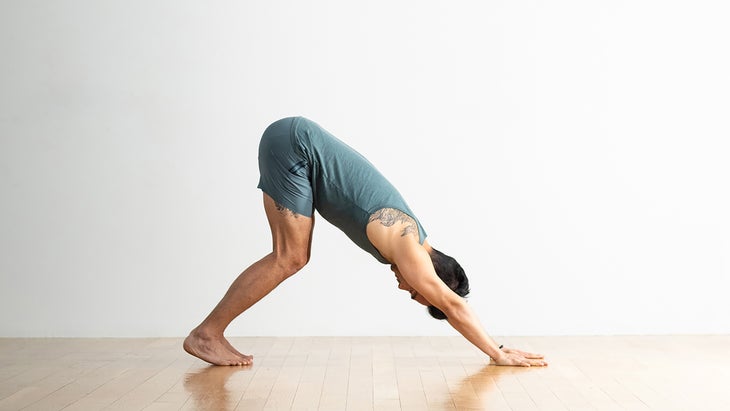
4. Downward-Facing Dog Pose (Adho Mukha Svanasana)
A classic yoga pose you know from vinyasa yoga, Downward Dog directs your attention inward but in an active fashion. Here you have the chance to practice noticing where you tense and tighten in response to a challenging situation. See if you can keep your breath slow and steady.
How to:
- From Child’s Pose, bring yourself to hands and knees.
- Tuck your toes, push the floor with your hands, and lift your hips up and back. Bend both knees deeply and work on keeping your hips lifted. If it’s more comfortable, place your hands on blocks to relieve pressure on your wrists.
- Draw your shoulder blades toward your hips and relax your neck. Let your heels drop toward the mat without forcing them to touch. If you can, start to straighten your knees a little. Notice if you’re holding your breath. Pause here for 5 to 10 breaths.

5. Standing Forward Bend (Uttanasana)
Known as an intense stretch for the lower body, Standing Forward Bend is also an opportunity to tune into what emotions you’re experiencing on the inside.
How to:
- From Down Dog, walk to the top of the mat and separate your feet at least hip-width apart. If you experience low-back pain, take your feet slightly wider.
- Bend your knees, hinge forward from your hips, and grasp opposite elbows or let your hands rest on the mat or blocks. Relax your neck and shoulders and let your head hang. Take 4 to 5 breaths.
- If you like, interlace your fingers behind your neck and rest your palms against the base of your head. Stay still or slowly sway your upper body side to side. Stay here for at least 4 to 5 breaths.
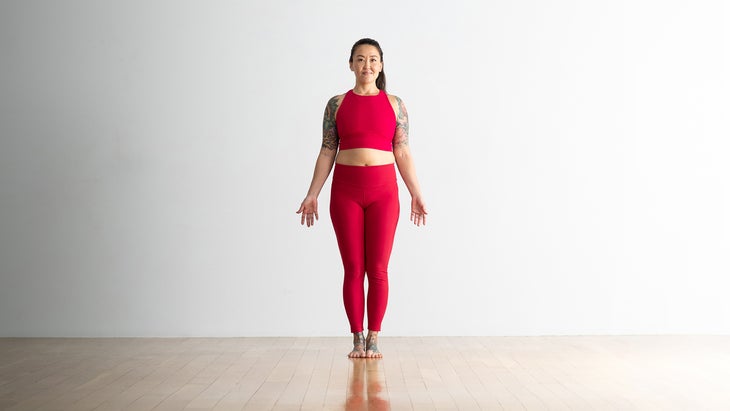
6. Mountain Pose (Tadasana)
This is a great example of how a seemingly simple yoga pose can engage the muscles throughout your whole body. It also requires you to find a balance of effort and ease, one of the foundational principles of yoga. As you stand in Mountain Pose, explore where you can release some tension.
How to:
- With your feet together or hip-width apart, inhale and slowly reach your arms skyward.
- As you exhale, relax them alongside your body, palms facing forward, in Mountain Pose. Stand with your shoulders, hips, knees, and ankles stacked. Notice if your head is tilted downward and lift the top of your head toward the ceiling to bring the back of your head in line with your back body. Relax your shoulders. You can close your eyes or softly focus your gaze on a single point that’s straight ahead. Stay here for 4 to 5 breaths or until you feel grounded and centered.

7. Chair Pose (Utkatasana)
But Chair Pose truly is an effective (and challenging) posture for bringing all of your mental and physical attention into the present moment.
How to:
- From Mountain Pose, with your feet parallel and toes pointing forward, bend your knees and reach your seat back as if you were about to sit in a chair. If you’d like, take a block between your thighs and squeeze. Breathe deeply for 5 to 10 breaths.
- Straighten your legs and come to standing for a few breaths. Repeat 1 to 2 more times.
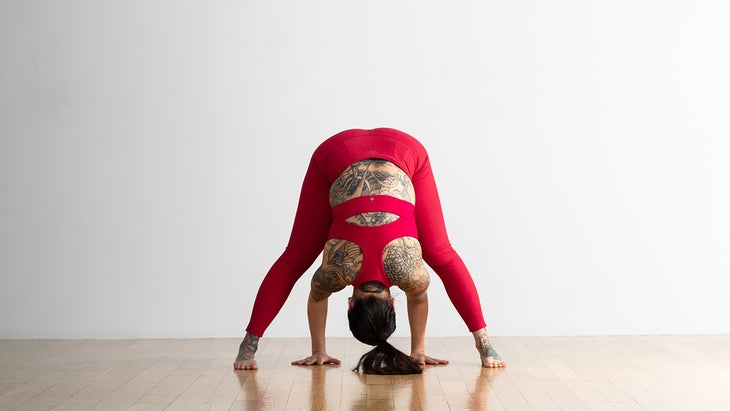
8. Wide-Legged Standing Forward Bend (Prasarita Padottanasana)
As your lower body engages to keep you balanced, notice where you can release tension in your shoulders, arms, neck, and face.
How to:
- From Mountain Pose, turn to face the long side of the mat and step your feet wide with your feet parallel to the short side of the mat.
- Bring your hands to your hips. Inhale as you lift your chest and exhale as you hinge from your hips and fold forward. Bring your hands underneath your shoulders to the floor or blocks. Draw your elbows toward each other rather than let them splay out to the sides.
- Subtly shift your weight forward and back on your feet and then come to a place in the center that feels balanced. Stay here for 5 to 10 breaths.
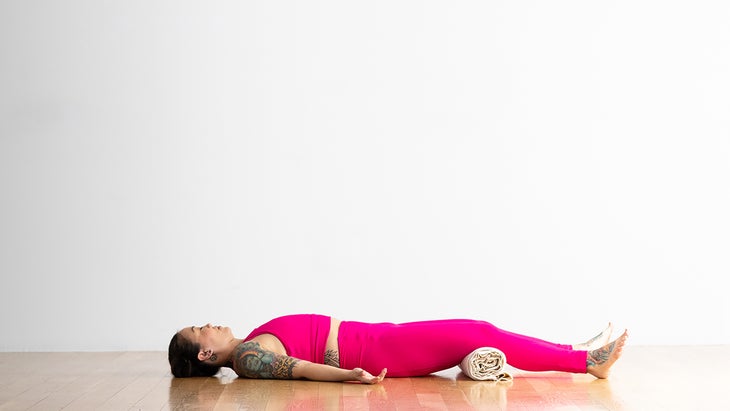
9. Corpse Pose (Savasana)
There may not be a more grounded pose than Savasana. Focus on your inhalations and exhalations. Staying present in this pose is enough to make you feel re-energized and realigned.
How to:
- Find a comfortable position on your back, with your feet at least hip-distance apart and falling out toward the side. Rest your arms a comfortable distance from your body.
- Relax as you inhale and exhale. Stay here for at least 2 minutes.
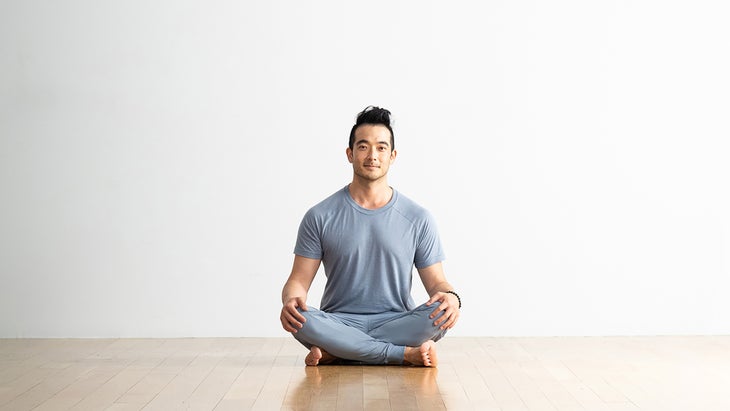
10. Easy Seat (Sukhasana)
Take a few more moments to end your grounding 20 minute yoga practice in a seated position: Easy Pose. Feel any subtle shifts in your body and your energy that the sequence has allowed you to experience. Remember this feeling and know that you can come back to it whenever you need.
How to:
- From Savasana, slowly draw your knees into your chest and roll onto one side.
- Take your time as you make your way to a cross-legged seat with your hips propped on a blanket or block, if that feels most comfortable.
- Allow your eyes to rest and find your breath. Stay here until you begin to feel ease in your breath.
This article has been updated. Originally published September 2, 2021.